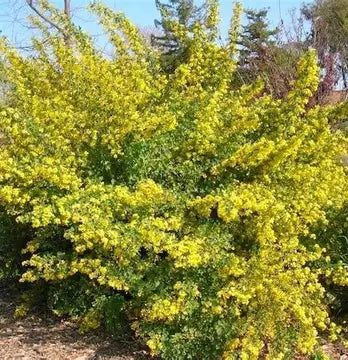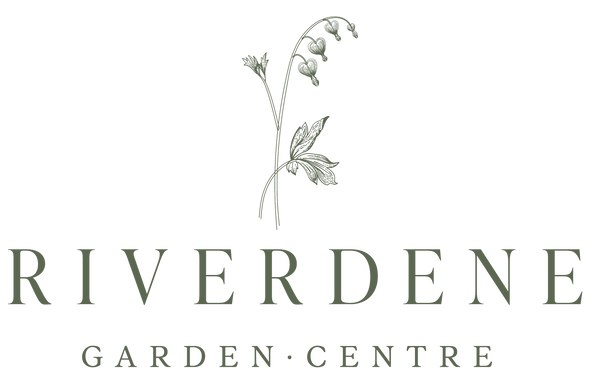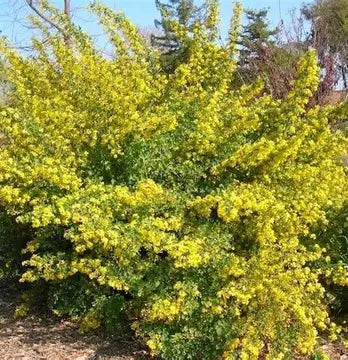Riverdene Garden Centre
Golden Flowering Currant
Golden Flowering Currant
Couldn't load pickup availability
Golden Flowering Currant (Ribes aureum) Care Guide
Overview:
Golden Currant is a cold-tardy, deciduous shrub known for its clusters of fragrant yellow (golden) flowers in spring, decorative foliage, and edible berries. It is relatively low maintenance, wildlife-friendly, and adaptable to a variety of growing conditions.
1. Planting & Growing Conditions
-
Hardiness Zones: Hardy in cold climates; suited to zones 3–8 (or similar) in many plant listings.
-
Mature Size:
• Height: ~ 4 to 8 ft (1.2 to 2.4 m) depending on variety and site conditions
• Spread: Often similar to height, sometimes somewhat broader -
Light Requirements:
• Full sun to partial shade — more sun encourages stronger flowering and denser habit. -
Soil Requirements:
• Prefers well-drained soils but is adaptable: tolerates a wide range from dry to moist soils.
• Tolerant of poorer soils and higher pH (alkaline) conditions in some locales. -
Moisture:
• Moderate water needs initially; once established more drought-tolerant.
• In hot or dry sites, supplemental irrigation improves appearance. -
Fertility:
• Does best under moderately low fertility; rich soils can produce overly lax growth. -
Spacing & Placement:
• Allow room for mature spread.
• Choose a location where the fragrant flowers can be appreciated (e.g., near walkways or patios).
• Not too close to large trees that cast deep shade.
2. Flowering, Fruit & Seasonal Interest
-
Bloom Time: Spring (often early to mid spring) — with clusters of golden yellow trumpeting flowers.
-
Fragrance: Flowers are often fragrant, somewhat spicy or clove-like.
-
Fruit:
• Small berries develop after flowering — colors may vary from amber to red to dark purple/black.
• Berries are edible (though tart) and used in jams, jellies, or by wildlife. -
Foliage / Fall Color:
• Leaves are lobed, often maple-like in shape.
• In autumn the leaves may turn shades of yellow, orange, or red.
3. Watering & Establishment
-
First 1–2 Years: Keep soil evenly moist (not waterlogged) especially during dry spells.
-
Once Established: More drought tolerant — water as needed during extended dry periods.
-
Mulching: Use 2–3 in of organic mulch around the base (keeping it a bit away from the stems) to retain moisture and suppress weeds.
4. Fertilizing
-
In early spring, a light application of balanced fertilizer is sufficient if the soil is not naturally rich.
-
Avoid excessive fertilization (especially high nitrogen) to prevent overly soft, weak growth.
-
In lower fertility sites, occasional amendments (compost, slow-release fertilizer) can help vigor but moderate inputs are best.
5. Pruning & Maintenance
-
Best Time to Prune: After flowering (late spring) — pruning too early can eliminate blooms.
-
Pruning Method:
• Remove dead, diseased, or damaged branches.
• Thin out older wood to encourage renewal (flowers often form on one- to three-year-old wood).
• Shape lightly, but avoid drastic pruning into old thick wood as the shrub may respond poorly. -
Renewal Pruning: On older shrubs, cutting some of the oldest stems to the ground can help stimulate new growth and maintain vigor.
6. Pests & Diseases
-
Potential Pests: Aphids occasionally, especially on new growth.
-
Diseases & Risks:
• Be aware that Ribes species can serve as alternate hosts for white pine blister rust. In areas where this disease is of concern, placement near white pines may require caution. -
General Prevention: Maintain good air circulation, avoid overhead watering, remove any diseased parts promptly.
7. Winter & Cold Protection
-
Golden Currant is quite hardy and generally requires no special protection in cold climates.
-
In young plantings or exposed locations, a layer of mulch at the root base can help buffer against extreme freeze-thaw cycles.
8. Landscape Uses & Benefits
Excellent as a specimen or accent shrub, especially where spring flower display and fragrance are desired
Works in wildlife gardens, pollinator gardens, or naturalized plantings — flowers attract bees, hummingbirds; berries feed birds.
Useful in hedges or border plantings when grouped, offering seasonal interest
Good in xeriscapes or lower-water gardens, thanks to drought adaptability
Serves as an ornamental with edible interest — the berries can be harvested for jam or preserves
Photo courtesy of Foothills Nursery.
Share


